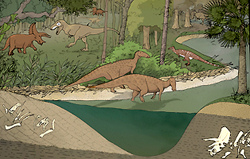The Winners of Mass Extinction: With Predators Gone, Prey Thrives
*Extinction of fishes 360 million years ago created natural ecology experiment*
In present-day ecology, the removal or addition of a predator in an ecosystem can produce dramatic changes in the population of prey species. For the first time, scientists have observed the same dynamics in the fossil record, thanks to a mass extinction that decimated ocean life 360 million years ago.
What was bad for fish was good for the fish’s food, according to a paper published online in Proceedings of the National Academy of Sciences. Researchers from the University of Chicago, West Virginia University and The Ohio State University found that the mass extinction known as the Hangenberg event produced a “natural experiment” in the fossil record, with results that mirror modern observations about predator-prey relationships. (more…)

